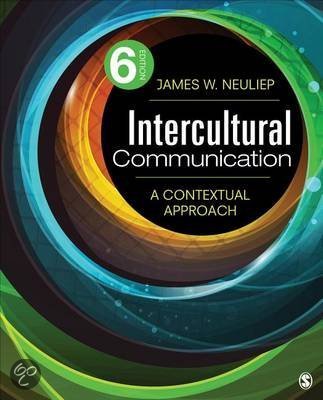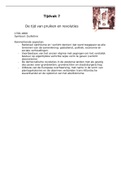Chapter 1 The Necessity of Intercultural Communication
Benefits intercultural communication
- Healthy Communities: are made up of individuals working collectively for
the benefit of everyone, not just their own group.
- Increased Commerce: to interact with persons from different cultures,
both inside and outside our borders, has immense economic benefits.
- Reduced Conflict: we will never be able to erase it. We can, however,
through cooperative intercultural communication, reduce and mange it.
- Personal Growth Through Tolerance
Dimensions of Communication
1. Process: is anything that is ongoing, ever changing, and continuous. It
doesn’t has a specific begin or ending, isn’t static or at rest; it is always
moving.
2. Dynamic: is considered active or forceful.
3. Interactive-Transactive: Communication is interactive and transactive,
because it occurs between people. It is participation of two people
sending (encodes) and receiving (decodes) messages.
4. Symbolic: are the vehicles by which the thoughts and ideas of one person
can be communicated to another person. Messages constructed with
verbal and non-verbal symbols.
5. Intentional: exists whenever two or more people consciously engage in
interaction with some purpose.
6. Contextual: context defines the meaning of any messages. Context is the
cultural, physical, relational and perceptual environment in which
communication occurs. (Context classroom students sit quietly and
listen to the professor)
7. Ubiquitous: communication is everywhere, done by everyone, all the time.
8. Cultural: shapes communication and communication is culture bound.
People from different cultures communicate differently. (how we
communicate is strongly influenced by our culture)
Intrapersonal communication: communicating with yourself
Facial expression: body language and eye contact are nonverbal messages
informing how the message is received.
Perceptual context: the motivations, intentions personality traits people bring to
the communication event.
Communication apprehension: the fear or anxiety people experience when
communicating with others (public speaking, class presentations, job interview)
Culture: an accumulated pattern of values, beliefs, and behaviours, shared by an
identifiable group of people with a common history and verbal and nonverbal
symbol systems.
Microcultures: exists within the broader rules and guidelines of the dominant
cultural milieu but are distinct in some way, perhaps radically or linguistically, or
via their sexual orientation, age, or even occupation. Microcultures often have
,histories that differ from the dominant culture group. Within most cultures,
separate groups of people coexist. (Amish, extreme example)
Intercultural communication: when people from different cultures come
together and communicate with one another
Context: refers to the setting, situation, circumstances, background and overall
framework within which communication occurs.
- Physical context: communicate with friends in your dorm room
- Social context: friend to friend
- Psychological context: your thought and emotions about your friend
A Contextual model of intercultural communication attempts to identify the
various contexts that define what happens when a person from culture A
communicates with a person from culture B. (conceptually and graphically
consistent)
- Cultural Context: an accumulated pattern of values, beliefs, and
behaviours, shared by an identifiable group of people with a common
history and verbal and nonverbal symbol systems. (come together and
talking to someone from a different culture)
- Microcultural Context: Within most cultures, separate groups of people
coexist. These groups are in some way different from the larger cultural
milieu.
- Environmental Context: Physical (when, where?), geographical
(architecture, landscape design,) local of the interaction. Also climate of a
particular culture. These factors play a key role on how people
communicate.
o Perceptual context: refers to the individual characteristics of each
interactant, including cognitions, attitudes, dispositions and
motivations. How an individual gathers, stores, and retrieves
information.
One’s culture and membership in microcultural groups significantly influence
how one perceives the environment.
Sociorelational context: the relationship between the interactants. Whenever
two people come together and interact, they establish a relationship.
Uncertainty: we may not know anything about the person’s culture, values,
habits, behaviour, dress, and so on. We may not know what to say or do in such
situations.
Intercultural communication apprehension: the fear or anxiety associated with
either real or anticipated interaction with people from different groups,
especially different cultural or ethic groups.
Ethnocentrism: the ide that one’s own culture is the centre of everything and all
other groups (or cultures) are scaled and rated with reference to it.
GENE (Generalized Ethnocentrism) Scale: is designed to measure ethnocentrism.
, Chapter 2 The Cultural Context
Individualism: individualists strive to maintain distinctive personal attitudes and
opinions and prefer self- directed behaviour and independence of groups.
Individualists tend to see themselves as unique from others.
Collectivism: interdependence, harmony and working with the group. Group
goals take precedence over individual goals.
Horizontal individualism: cultural orientation where an autonomous/
independent self is valued but the individual is more or less equal in status to
others. Sweden/Austria
Vertical individualism: Autonomous/independent self is valued but is different
and unequal with others. USA/France
Horizontal collectivism: Individual sees him/herself as member of in-group and
equal with others. China
Vertical collectivism: Individual sees him/herself as integral part of in-group but
its members are different from each other. Japan, India and rural Greece.
Contextual features: Culture (race, language), Physical environment (office,
church), sociorelational (superior/subordinate), perceptual (attitudes,
emotions)
Low-context: the verbal code is the primary source of information. Low-context
cultures generally rely on elaborated (uitgebreid) codes.
High context: the interactanct will look to the physical, sociorelational and
perceptual environment for information.
Power distance: the extent to which the less powerful members of institutions
and organisation within a country expect and accept that power is distributed
unequally.
Uncertainty avoidance: the degree to which the members of a particular culture
feel threatened by uncertain or unknown situations.
Uncertain situation Active engagement
/
Uncertainty orientation /
\
\
Certain situation passive disengagement
Uncertain situation Passive disengagement
/
Certainty orientation /
\
\
Certain situation active engagement




